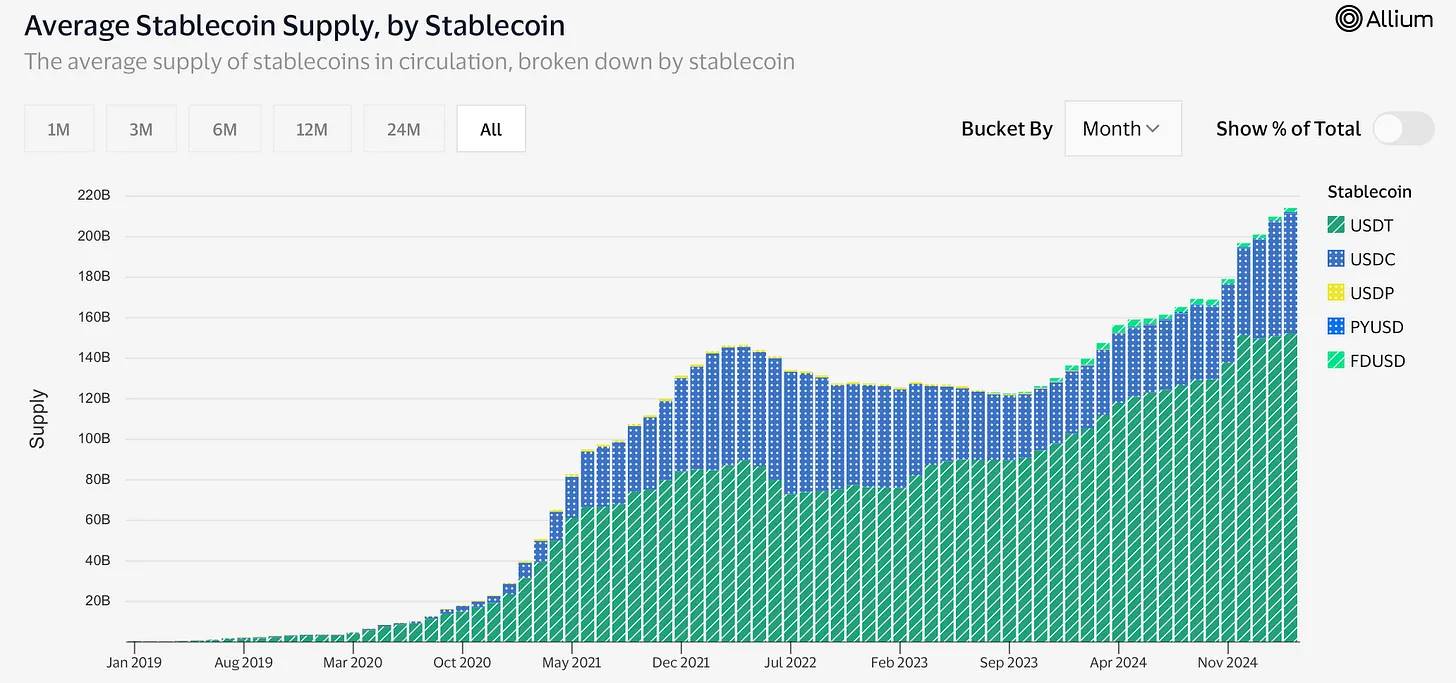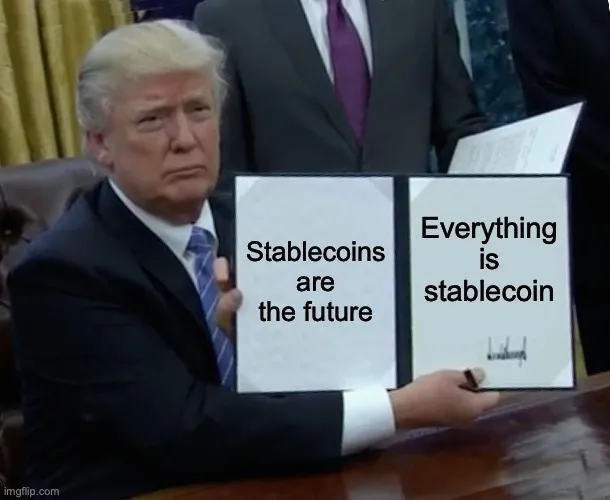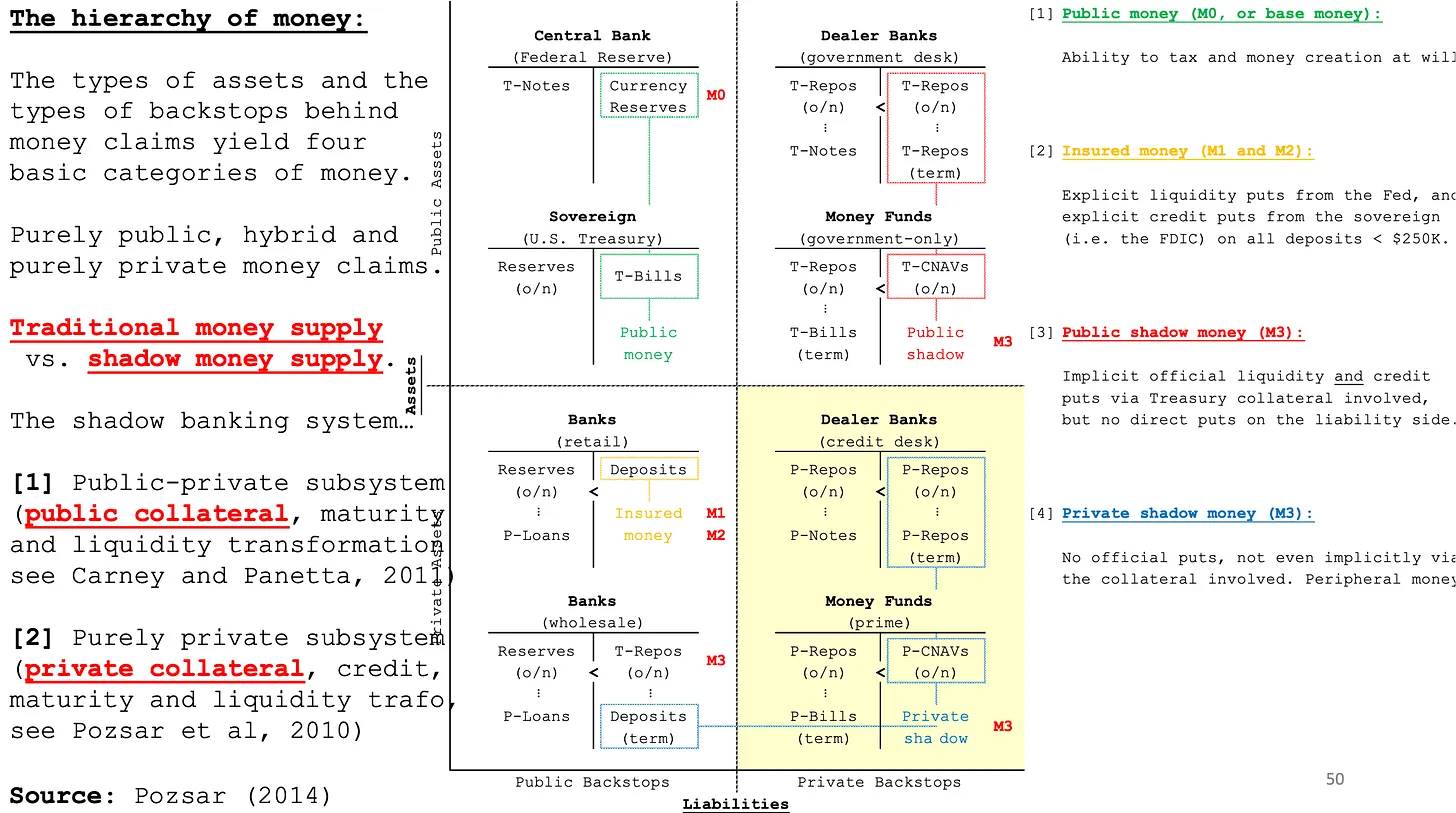编译:深潮TechFlow
大家好,SQUIDs!今天我们来解析一下美国国会的两项稳定币法案。
预计最终的稳定币法案将在2025年晚些时候通过,因此了解法案的内容以及它将如何影响我们的行业至关重要。
引言
我们正处于牛市,一个属于稳定币的牛市。

自FTX崩盘后市场触底以来,稳定币的供应量在18个月内翻了一倍,达到了2150亿美元。这还不包括像Ondo、Usual、Frax和Maker这样新兴的加密货币专属参与者。
在当前4%-5%的利率水平下,稳定币行业利润丰厚。Tether去年在不到50名员工的情况下创下了140亿美元的利润!Circle计划在2025年申请上市。一切都围绕着稳定币展开。

随着拜登离任,2025年我们几乎可以肯定会迎来稳定币立法。银行眼看着Tether和Circle抢占市场先机长达五年。一旦新法律通过并使稳定币合法化,美国的每一家银行都会发行自己的数字美元。
目前有两个主要的立法提案正在推进:参议院的《2025年美国稳定币创新国家指导与建立法案》(Guiding and Establishing National Innovation for U.S. Stablecoins Act,简称GENIUS法案)和众议院的《2025年稳定币透明度与责任促进更好账本经济法案》(Stablecoin Transparency and Accountability for a Better Ledger Economy Act,简称STABLE法案)。
这些法案已经在立法程序中反复讨论很久了……但现在终于达成了共识,今年其中之一将会通过。
GENIUS法案和STABLE法案的共同目标是为“支付稳定币”发行方创建联邦许可制度,确立严格的储备要求,并明确监管职责。
支付稳定币(Payment Stablecoins)只是一个好听的术语,指的是由银行或非银行机构根据其资产负债表授权发行的数字美元。它被定义为用于支付或结算的数字资产,其价值与固定货币价值挂钩(通常是与美元1:1挂钩),并以短期国债或现金作为储备。
稳定币的批评者认为,这将削弱政府控制货币政策的能力。想了解他们的担忧,可以阅读戈尔顿(Gorton)和张(Zhang)撰写的经典文章《驯服野猫稳定币》(Taming Wildcat Stablecoins)。
现代时代美元的首要规则就是:绝不能脱锚。
无论在哪里,一美元就是一美元。
存入摩根大通(JP Morgan)、放在Venmo或PayPal里,甚至是Roblox中的虚拟积分,无论美元在哪里使用,它都必须始终满足以下两条规则:
-
每一美元必须可互换:不能对美元进行心理分类,贴上“特殊”、“保留”或与特定用途挂钩的标签。摩根大通里的美元不能被认为与特斯拉资产负债表上的美元有所不同。
-
美元具有可替代性:无论在哪里,所有美元都是“相同”的——现金、银行存款、储备都一样。
整个法定金融体系都是围绕这一原则构建的。
这也是美联储的全部职责所在——确保美元保持锚定并强劲运行。绝不脱锚。

上方这张幻灯片摘自佐尔坦·波扎尔(Zoltan Pozsar)的《金融系统如何运作》(How the Financial System Works)。这是关于美元的权威指南,能够为你提供大量背景信息,帮助理解这些稳定币法案试图实现的目标。
目前,所有稳定币都归类于右下角的“私人影子货币”(Private Shadow Money)。如果Tether或Circle被关闭或破产,对加密行业来说可能是灾难性的,但对整体金融系统的影响却微乎其微。生活仍会照常继续。
经济学家担心的是,一旦稳定币被合法化,允许银行发行它们,并将它们变成“公共影子货币”(Public Shadow Money),风险才会真正显现。
因为,在法定货币体系中,唯一重要的问题是:当危机爆发时,谁会得到救助。这正是上方幻灯片所展示的核心。
还记得2008年吗?当时,美国的抵押贷款支持证券(MBS)在全球经济中所占比例非常小,但银行始终以接近100倍杠杆运作,且抵押品在各银行的资产负债表之间交叉流动。因此,当一家银行(雷曼兄弟)崩溃时,由于杠杆作用和资产负债表的连锁传染,触发了一系列类似的爆炸性倒闭。
美国联邦储备(美联储)以及欧洲央行(ECB)等其他货币机构不得不(在全球范围内)介入,以确保所有银行的资产负债表免受这些“有毒债务”的影响。虽然耗费了数十亿美元的救助资金,但银行得以被拯救。美联储永远会救助银行,因为没有银行,全球金融体系将无法运转,而美元可能会在那些资产负债表糟糕的机构中脱锚。
其实,你甚至不需要回到2008年,就能看到类似的例子。
2023年3月,硅谷银行(Silicon Valley Bank)在一个周末内迅速倒闭,原因是一场由数字提现和社交媒体恐慌言论引发的银行挤兑。硅谷银行的失败并非因为高风险的按揭贷款、衍生品或加密货币,而是由于持有了所谓“安全”的长期美国国债,而这些债券在利率上升时价值大幅缩水。然而,尽管硅谷银行在整个银行体系中规模相对较小,其倒闭仍然威胁到了系统性传染风险,迫使美联储(Fed)、联邦存款保险公司(FDIC)和财政部迅速介入,保证所有存款安全——即使是超过25万美元标准保险限额的存款。这场政府的迅速干预凸显了一个原则:当任何地方的美元变得不可信时,整个金融体系可能会在一夜之间崩溃。
硅谷银行的倒闭立即对加密市场产生了连锁反应。USDC的发行方Circle当时持有约300亿美元的总供应量,其中相当一部分储备存放在硅谷银行。在那个周末,USDC脱锚了大约8美分,短暂交易价跌至约0.92美元,引发了加密市场的恐慌。现在,试想一下,如果这种资产脱锚现象发生在全球范围内会怎样?这正是这些新稳定币法案所面临的风险所在。通过允许银行发行自己的稳定币,政策制定者可能会将潜在的不稳定工具更深地嵌入全球金融基础设施,从而在下一次金融冲击发生时(而不是“如果”,而是“何时”)大幅提高风险。
佐尔坦·波扎尔(Zoltan Pozsar)幻灯片的核心观点在于,当金融灾难发生时,最终必须由政府出面拯救金融体系。
如今,我们有多个类别的美元,每种美元的安全性级别各不相同。
由政府直接发行的美元(即M0美元)享有美国政府的完全信用担保,基本上是无风险的。然而,当资金进入银行系统,并被分类为M1、M2和M3时,政府的担保逐渐减弱。
这正是银行救助备受争议的原因所在。
银行信贷是美国金融体系的核心,但银行在法律允许范围内往往有激励去追求最大风险,常常导致危险的过度杠杆化。当这种风险行为越界时,金融危机就会爆发,而美联储不得不介入并提供救助,以防止整个系统性崩溃。
担忧在于,今天绝大多数的货币都以银行发行的信贷形式存在,而银行之间存在深度互联和杠杆化。如果多家银行同时倒闭,可能会引发多米诺效应,将损失扩散至每个行业和资产类别。
2008年,我们已经见证了这种情况的真实发生。
很少有人会想到,美国住房市场中一个看似孤立的领域竟能动摇全球经济,但由于极端的杠杆化和脆弱的资产负债表,一旦曾被认为安全的抵押品崩溃,银行便无法承受其冲击。
这种背景有助于解释,为何稳定币立法一直存在巨大分歧且进展缓慢。
因此,立法者采取了谨慎的态度,仔细定义什么才算是稳定币,以及谁有资格发行稳定币。
这种谨慎态度催生了两项相互竞争的立法提案:GENIUS法案(GENIUS Act)和STABLE法案(STABLE Act)。前者对稳定币发行采取更灵活的方式,而后者则对发行资格、利息支付和发行方资质设立了严格限制。
然而,这两项法案都代表了向前迈出的关键一步,可能为链上交易释放数万亿美元的潜力。
接下来,让我们详细分析这两项法案,了解它们的相似点、不同点,以及最终的潜在影响。
GENIUS法案:参议院的稳定币框架
2025年的《GENIUS法案》(Guiding and Establishing National Innovation for U.S. Stablecoins Act,指导并确立美国稳定币国家创新法案)由参议员比尔·哈格蒂(Bill Hagerty,田纳西州共和党)于2025年2月提出,并得到了两党共同支持,包括参议员蒂姆·斯科特(Tim Scott)、克尔斯滕·吉利布兰德(Kirsten Gillibrand)和辛西娅·鲁米斯(Cynthia Lummis)等人的参与。
2025年3月13日,该法案以18票赞成、6票反对的结果通过了参议院银行委员会的审议,成为首个通过该委员会的加密货币相关法案。
根据《GENIUS法案》,稳定币被明确定义为与固定货币价值挂钩的数字资产,通常以1:1的比例与美元挂钩,主要用于支付或结算目的。
尽管还有其他类型的“稳定币”,例如Paxos的PAXG(与黄金挂钩),但根据目前的《GENIUS法案》,与黄金或石油等商品挂钩的代币通常不在其监管范围之内。目前,该法案仅适用于法币挂钩的稳定币。
商品支持型代币通常受商品期货交易委员会(CFTC)或证券交易委员会(SEC)的现有法规监管,具体取决于其结构和用途,而不是受稳定币特定立法的约束。
如果未来比特币或黄金成为主导的支付货币,而我们都迁移到比特币支持的堡垒中生活,那么该法案可能会适用,但目前它们仍然不在《GENIUS法案》的直接监管范围内。
这是一个共和党主导的法案,其出台是因为拜登政府和民主党在上一届政府中拒绝起草任何与加密货币相关的立法。
该法案引入了一项联邦许可制度,规定只有获得授权的实体才能发行支付型稳定币,并设立了三类许可发行方:
-
银行子公司:由受保存款机构的子公司(例如银行控股公司)发行稳定币。
-
非保险存款机构:包括信托公司或其他州特许的金融机构,这些机构接受存款但不受联邦存款保险公司(FDIC)保险(当前许多稳定币发行方的状态)。
-
非银行实体:为非银行稳定币发行方设立的新联邦特许类别(在法案中有时被称为“支付型稳定币发行方”),这些实体将由联邦货币监理署(OCC)特许并监管。
正如你所猜测的,所有发行方都必须以高质量的流动性资产(包括现金、银行存款或短期美国国债)全额1:1支持其稳定币。此外,这些发行方需要定期通过注册会计师事务所进行公开披露和审计,以确保透明度。
《GENIUS法案》的一个亮点是其双重监管结构。它允许较小的发行方(未发行超过100亿美元稳定币的机构)在州监管范围内运营,前提是其所在州的监管标准达到或超过联邦指南。
怀俄明州是第一个探索发行自有稳定币并受当地法律管理的州。
较大的发行方则需要在联邦直接监管下运营,主要由联邦货币监理署(OCC)或适当的联邦银行监管机构监督。
值得注意的是,《GENIUS法案》明确规定,合规的稳定币既不是证券也不是商品,从而明确了监管管辖权,并缓解了可能受到SEC或CFTC监管的担忧。
过去,批评者曾呼吁将稳定币作为证券进行监管。而通过这种分类,稳定币可以更广泛且便捷地分发。
STABLE法案:众议院规则
由众议员布莱恩·斯蒂尔(Bryan Steil,威斯康星州共和党)和弗伦奇·希尔(French Hill,阿肯色州共和党)于2025年3月提出,《稳定币透明与责任促进更佳账本经济法案》(Stablecoin Transparency and Accountability for a Better Ledger Economy Act,简称STABLE法案)与GENIUS法案非常相似,但它引入了独特的措施以缓解金融风险。
最显著的一点是,该法案明确禁止稳定币发行方向持有者提供利息或收益,确保稳定币严格作为现金等价的支付工具,而非投资产品。
此外,STABLE法案对新型算法稳定币的发行实施了两年的暂停期。这类稳定币仅依赖数字资产或算法来维持其挂钩价值,此举旨在等待进一步的监管分析和保护措施出台。
两项法案,共享法律基础
尽管存在一些差异,GENIUS法案和STABLE法案在稳定币监管的基础原则上体现了广泛的两党共识。两项法案在以下方面达成一致:
-
严格要求稳定币发行方获得许可,以确保监管监督。
-
要求稳定币保持完全1:1的支持,以高流动性、安全的储备资产作为后盾,防范破产风险。
-
实施强有力的透明度要求,包括定期公开披露和独立审计。
-
建立明确的消费者保护措施,如资产隔离和发行方破产时的优先索赔权。
-
通过明确将稳定币归类为非证券或商品,提供监管清晰性,从而简化司法管辖权和监管流程。
尽管共享基础原则,GENIUS法案与STABLE法案在以下三大关键点上存在分歧:
-
利息支付:
GENIUS法案允许稳定币向持有者支付利息或收益,从而为金融领域的创新和更广泛的应用场景打开了大门。相比之下,STABLE法案严格禁止利息支付,将稳定币明确限定为纯粹的支付工具,并明确排除其作为投资或收益资产的功能。
-
算法稳定币:
GENIUS法案采取谨慎但宽松的态度,要求监管机构密切研究和监控此类稳定币,而非立即全面禁止。相反,STABLE法案对新算法稳定币的发行采取了明确且直接的两年暂停政策,这反映了在经历过往市场崩盘后更为谨慎的立场。
-
州与联邦监管门槛:
GENIUS法案明确规定,当发行方的稳定币总额达到100亿美元时,必须从州监管过渡到联邦监管,从而清晰界定了何时一个稳定币发行方具有系统性重要性。STABLE法案则隐含支持类似的门槛,但未明确规定具体数值,赋予监管机构更多的自由裁量权,能够根据市场发展进行持续调整。
为什么禁止利息?稳定币收益禁令解析
众议院《STABLE法案》(以及此前的一些提案)中引人注目的一个条款,是禁止稳定币发行方向代币持有者支付利息或任何形式的收益。
实际上,这意味着合规的支付型稳定币必须像数字现金或储值工具一样运作——你持有1枚稳定币,它始终可兑换为1美元,但随着时间的推移,它不会为你带来任何额外收益。
这与其他金融产品形成了鲜明对比,例如银行存款可能会产生利息,或者货币市场基金会积累收益。
那么,为什么要施加这样的限制?
这一“禁止利息规则”的背后有多方面的法律和监管原因,主要基于美国证券法、银行法以及相关监管指导原则。
避免被归类为证券(Howey测试)
禁止支付利息的一个主要原因是为了避免稳定币根据Howey测试被认定为投资证券。
Howey测试源自1946年美国最高法院的一起案件。根据该测试,如果某种资产符合以下条件,则被视为“投资合同”(因此属于证券):即存在资金投资于一个共同企业,并且投资者期望通过他人的努力获得利润。而严格作为支付代币功能的稳定币并非旨在提供“利润”,它只是一个价值稳定的1美元代币。
然而,一旦发行方开始提供回报(例如某种稳定币通过储备金支付4%的年化收益率),用户就会期待从发行方的努力中获利(发行方可能通过投资储备金来产生收益)。这可能触发Howey测试,从而引发美国证券交易委员会(SEC)声称该稳定币是证券发行的风险。
事实上,前SEC主席加里·根斯勒(Gary Gensler)曾暗示,一些稳定币可能属于证券,特别是如果它们类似于货币市场基金的股份或具有利润特征。为规避这一风险,《STABLE法案》的起草者明确禁止向代币持有者支付任何形式的利息或红利,确保没有“利润预期”。这样,稳定币就能保持其作为实用支付工具的属性,而不是投资合同。通过这一方式,国会可以有信心地将受监管的稳定币归类为非证券,这也是两项法案共同的立场。
然而,这项禁令的问题在于,目前链上已经存在带有利息的稳定币,例如Sky的sUSDS或Frax的sfrxUSD。禁止利息只会为希望探索不同商业模式和系统的稳定币公司增加不必要的障碍。
维护银行与非银行业务的界限(银行法)
美国银行法传统上将吸收存款的活动划归为银行(以及储蓄机构/信用合作社)的专属领域。(存款本质上是证券) 《1956年银行控股公司法案》(BHCA)及相关法规禁止商业公司向公众吸收存款——如果你吸收存款,你通常需要成为一家受监管的银行,否则可能被认定为银行,从而引发一系列监管要求。
当客户将资金交给你,而你承诺返还这些资金并支付利息时,这实际上是一种存款或投资票据。
监管机构已表明,过于类似银行存款功能的稳定币可能会触及这些法律界限。
通过禁止支付利息,STABLE法案的起草者旨在确保稳定币不会看起来像伪装成无保险银行账户的工具。相反,稳定币更像是储值卡或预付余额,而这些是非银行机构在特定法规下被允许发行的。
正如一位法律学者所言,公司不应仅仅因为其吸收存款的行为被包装成稳定币,就能够“规避《联邦存款保险法》和《银行控股公司法》的合规要求”。
实际上,如果允许稳定币发行方向持币者支付利息,他们可能会与银行争夺类似存款的资金(但却没有银行的监管保障措施,比如FDIC保险或美联储的监管),而这显然是银行监管机构难以接受的。
此外需要注意,美国的美元及金融体系完全依赖于银行能够发行贷款、抵押贷款以及其他形式的债务(用于住房、商业和其他商品及贸易),这些贷款通常具有极高的杠杆率,并由零售银行存款作为储备要求的支撑。
JP Koning对PayPal美元的分析在这里颇具启发意义。目前,PayPal实际上提供了两种形式的美元。
一种是我们熟悉的传统PayPal余额——这些美元存储在一个传统的集中式数据库中。另一种是较新的、基于加密技术的美元,即PayPal USD,它存在于区块链上。
你可能会认为传统版本更安全,但令人惊讶的是,PayPal的加密美元实际上更安全,并且提供了更强的消费者保护。
原因如下:PayPal的传统美元并不一定由最安全的资产支持。
如果仔细查看其披露信息,你会发现PayPal仅将约30%的客户余额投资于顶级资产,如现金或美国国债。而剩下的近70%则投资于风险更高、期限更长的资产,比如公司债务和商业票据。
更令人担忧的是,从严格的法律意义上来说,这些传统余额实际上并不属于你。
如果PayPal破产,你将成为一名无担保债权人,需要与PayPal欠款的其他人竞争,能否全额拿回你的余额都不一定。
相比之下,PayPal USD(加密版本)必须按照纽约州金融服务部的要求,100%由超安全的短期资产(如现金等价物和美国国债)支持。
不仅支持资产更安全,而且这些加密余额明确属于你:支持这些稳定币的储备必须在法律上为持有者的利益而设立。这意味着如果PayPal破产,你将优先于其他债权人拿回你的资金。 这一区别尤为重要,尤其是在考虑更广泛的金融稳定性时。像PayPal USD这样的稳定币不受更广泛银行体系的资产负债表风险、杠杆或抵押品问题的影响。
在金融危机中——正是你最需要安全的时候——投资者可能会涌向稳定币,正因为它们没有与银行的高风险贷款行为或部分准备金的不稳定性纠缠在一起。讽刺的是,稳定币最终可能更像是一种避险工具,而不是许多人所认为的那种高风险投机工具。
这对银行体系来说是个大问题。在2025年,资金的流动速度与互联网的速度一样快。硅谷银行(SVB)的倒闭正是由于受惊的投资者迅速进行数字化提款,这加剧了其问题,并最终导致了其彻底崩溃。
稳定币本质上是一种更优质的货币,而银行对此感到极度恐惧。
这些法案的折中方案是允许非银行公司发行美元代币,但前提是它们不能跨入支付利息的领域——从而避免直接侵犯银行提供利息账户的领地。
这条界限非常明确:银行吸收存款并将其贷出(可以支付利息),而根据该法案,稳定币发行方必须仅仅持有储备金并促进支付(不贷款,不支付利息)。
这实际上是对“窄银行”(Narrow Banking)概念的现代化演绎,其中稳定币发行方几乎充当了一个100%储备机构的角色,不应进行期限转换或提供收益。
历史类比(《格拉斯-斯蒂格尔法案》和Q条例)
有趣的是,关于用于支付的货币不应支付利息的观点在美国的监管历史上由来已久。
《1933年格拉斯-斯蒂格尔法案》因将商业银行与投资银行分离而闻名,但它还引入了Q条例(Regulation Q),该条例在几十年间禁止银行对活期存款账户(即支票账户)支付利息。当时的理由是防止银行之间为吸收存款而进行不健康的竞争,并确保银行的稳定性(20世纪20年代过高的利息优惠导致了冒险行为,进而促成了银行倒闭)。
尽管Q条例的禁令最终被逐步废除(2011年完全废止),其核心原则仍然是:你的流动性交易余额不应同时作为一个能赚取利息的投资工具。
稳定币从设计上来说,旨在成为高度流动的交易余额——加密货币领域的支票账户余额或钱包中的现金等价物。通过禁止为稳定币支付利息,立法者实际上是在呼应这一古老的理念:让支付工具保持安全和简单,并将其与收益型投资产品分离。
这也避免了可能出现的无保险影子银行的形态。(参见Pozsar的观点,记住私人影子银行无法获得救助。)
如果稳定币发行方提供利息,它们实际上就像银行一样运作(吸收资金,将其投资于国债或贷款以产生利息)。
但与银行不同的是,除了储备规则外,它们的贷款或投资活动不会受到监管,而用户可能会将它们视为与银行存款一样安全,却没有意识到其中的风险。
监管机构担心,这可能在危机中引发“银行挤兑”风险——如果人们认为稳定币和银行账户一样好,而它开始出现问题,他们可能会争相赎回,从而可能引发更广泛的市场压力。
因此,不支付利息的规则迫使稳定币发行方持有储备金,但不能从事任何贷款或通过冒险行为追逐收益,这大大降低了挤兑风险(因为储备始终等于负债)。
这种划分通过防止资金大规模流入未受监管的准银行工具,保护了金融体系的稳定性。
有效性、实用性及影响
该法案的直接结果是将稳定币完全纳入监管范围,使其变得更安全、更透明。
目前,像Circle(USDC)和Paxos(PayPal USD)这样的稳定币发行方自愿遵守严格的州级法规,尤其是纽约的信托框架,但尚不存在统一的联邦标准。
这些新法律将建立统一的国家标准,为消费者提供更高的保障,确保每一美元稳定币真正以高质量的资产(如现金或短期国债)1:1支持。
这是一个重大胜利:它巩固了信任,使稳定币更安全、更可信,尤其是在经历了像UST和硅谷银行(SVB)倒闭这样的重大事件之后。
此外,通过明确合规的稳定币不是证券,消除了SEC意外打击的持续威胁,将监管权转移到更适合的金融稳定性监管机构。
在创新方面,这些法案出人意料地具有前瞻性。
与早期严格的提案(如2020年最初的STABLE草案,仅允许银行发行)不同,这些新的法案为金融科技公司甚至大型科技公司提供了发行稳定币的途径,方法是获得联邦许可证或与银行合作。
想象一下,像亚马逊、沃尔玛甚至谷歌这样的公司推出品牌化的稳定币,并在其庞大的平台上广泛接受。
2021年,Facebook尝试推出Libra时已经遥遥领先于时代。未来每个公司可能都会有自己的品牌化美元。甚至连网红和其他私人个人也可能推出自己的稳定币……
你会买吗?比如“埃隆币”(ElonBucks)?或者“特朗普币”(Trumpbucks)?
我们已经准备好了。
然而,这些法案并非没有很好地权衡取舍。
目前还无人能预见去中心化稳定币的未来会如何。可以肯定的是,它们很难应对资本储备要求、牌照费用、持续审计以及其他合规成本。这可能会无意中偏向于像Circle和Paxos这样的行业巨头,同时挤压较小的或去中心化的创新者。
那么,DAI会发生什么呢?如果无法获得牌照,它们可能不得不退出美国市场。同样的情况也适用于Ondo、Frax和Usual。目前它们都不符合现行状态下的监管要求。今年晚些时候,我们可能会迎来一次大规模的行业洗牌。
结论
美国推动稳定币立法的努力展示了短短几年间相关讨论的巨大进展。
曾经处于边缘地带的事物,如今已站在新金融革命的最前沿,并且即将获得官方的监管认可,尽管这种认可附带严格的条件。
我们已经取得了长足进步,而这些法案将释放一波新的稳定币发行浪潮。
《GENIUS法案》略微倾向于在监管的框架下允许市场创新(如支付利息或新技术),而《STABLE法案》在这些方面则采取更为谨慎的态度。
随着立法进程的推进,这些分歧将需要得到调和。然而,鉴于两党对该议题的支持以及特朗普政府公开表示希望在2025年底前通过一项法案,我们可以预见,这些法案之一将成为现实。
对我们的行业和美元来说,这无疑是一个巨大的胜利。
免责声明:本文章仅代表作者个人观点,不代表本平台的立场和观点。本文章仅供信息分享,不构成对任何人的任何投资建议。用户与作者之间的任何争议,与本平台无关。如网页中刊载的文章或图片涉及侵权,请提供相关的权利证明和身份证明发送邮件到support@aicoin.com,本平台相关工作人员将会进行核查。




